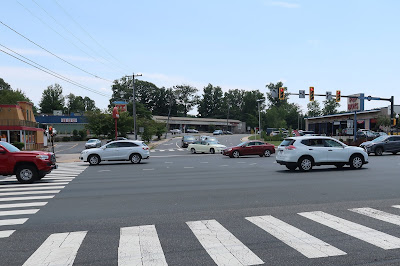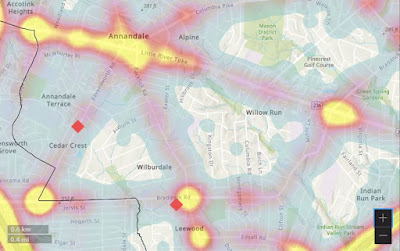Let’s make our streets safer for walking and biking
 |
| Little River Turnpike at John Marr Drive in Annandale. |
By Phil Kemelor
Have you almost been hit by a car when walking or cycling?
Now you can report those “near misses” and help make your streets safer.
Just go to the Northern Virginia Families for Safe Streets (NoVA FSS) Near Miss/Dangerous Location Survey and report what happened, where it happened, and when it happened.
Developed with support from Virginia Tech Master’s in Urban and Regional Planning program, NoVA FSS is collecting, analyzing, and sharing the data with police and relevant transportation agency staff to advocate for and help inform decisions to:
- Improve road infrastructure;
- Increase police vigilance at specific locations;
- Develop better traffic safety regulations; and
- Strive to accomplish the Vision Zero goal of zero traffic fatalities and serious injuries in Fairfax County, Alexandria, and Arlington.
“People experience too many close calls on our streets – times when they were nearly in a crash or saw dangerous conditions on our streets that could lead to crashes in the future,” says NoVa FSS founder Mike Doyle.
“Collecting and sharing these experiences gives us an opportunity to identify dangerous street safety patterns before crashes occur and help us to alert the relevant authorities so such dangerous conditions can be addressed,” Doyle says.
 |
| The data visualization available on the Near Miss Survey website highlights some of the hot spots in Annandale. |
Based on incident reports logged in the Near Miss survey since it was launched on June 17, 54 percent of the incidents involve pedestrians and 17 percent involve cyclists.
Overwhelmingly, 57 percent of the reported incidents occur when drivers fail to yield to people in a crosswalk. This was tragically illustrated on June 4, when a 24-year-old cyclist, Fatima Del Carmen Alvarez Romero, was struck by a car and killed in a crosswalk in the Huntington neighborhood.
In addition, speeding and stop-sign running contribute to nearly 50 percent of the reported near-miss incidents. Time of day is a significant factor, as well, with over 50 percent of the incidents occurring during the afternoon rush hour and spiking between 5 and 6 p.m.
With more submissions by more people, we will be able to tell a more complete story to decision-makers who can make our streets safer.
Northern Virginia Families for Safe Streets is an advocacy organization that has the goal to create streets that are safe for walkers and cyclists. We do this by educating our communities and public policymakers and by working on programs and activities to make our streets safer.
To learn more about the survey, watch this short video.
Please share the survey link on your neighborhood listservs and social media and with your school and community groups.
Phil Kemelor is a member of Northern Virginia Families for Safe Streets.


Thanks for this Phil. This survey process is a great service to help improve pedestrian and cyclist safety. I hope this survey gets widely distributed and used by pedestrians and cyclists as it is an important way to reach public officials to get their action to improve safety.
Thanks, Larry! Appreciate anything you can do to help get the word out!
Can I report when a cyclist blows by me as I am making a right hand turn, and then continues along on John Marr crossing Little River Turnpike?
Yes!Absolutely!
Unfortunately, this survey is of little value since it does not identify instances when the pedestrian or bicyclist were the cause of the incident. It is anecdotal information at best and from the singular perspective of the pedestrian/bicyclists who may have caused the incident. Using the results to affect public policy would be unwise and may serve to make the situation worse by focusing attention away from areas of actual need.
Actually you can report if a pedestrian or cyclist is the cause. Anecdotal information is valuable to inform police and officials that an incident occurred at a location. It is used with other information gathered to give officials a "heads up" that the location in question may require further study or research.